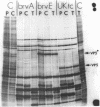Abstract
Three variants of group A rotavirus with large changes in their gene 5 structures have been analyzed at the molecular level. The first of these, P9 delta 5, was obtained during plaque purification undertaken as part of the biological cloning of a field isolate of virus. The gene 5 homolog in this isolate migrated just ahead of the normal segment 6 RNA, giving an estimated size of 1,300 bp. Molecular cloning and sequencing of this homolog revealed it to have a single 308-bp deletion in the center of the normal gene 5 sequence extending between nucleotides 460 and 768 of the normal gene sequence. This deletion caused a frameshift in the gene such that a stop codon was encountered 8 amino acids downstream of the deletion point, giving a predicted size for the protein product of this gene of 150 amino acids compared with the 490 amino acids of its normal-size counterpart. Attempts to detect this shortened protein in virus-infected cells were not successful, indicating that it was much less stable than the full-length protein and/or had suffered a large change in its antigenicity. The second two variants, brvA and brvE, were generated in an earlier study following the high-multiplicity passage of the UKtc strain of bovine rotavirus. Polyacrylamide gel electrophoresis analysis of these nondefective variants showed that brvA had a gene 5 homolog approximately equal in size to the normal RNA segment 2 (approximately 2,700 bp) and that brvE had a size of approximately 2,300 bp. Both variants showed changes in their gene 5 protein products, with brvA mimicking P9 delta 5 in failing to produce a detectable product whereas brvE produced a new virus-specific protein approximately 80 kDa in size. Full-length cDNA clones of the brvE gene 5 homolog were isolated, and analysis of their structure revealed a head-to-tail concatemerization of the normal gene 5 sequence with the first copy of the concatemer covering nucleotides 1 to 808 and the second covering nucleotides 92 to 1579, giving a total length of 2,296 bp. Sequencing across the junction region of the two copies of the gene showed that they were joined in frame to give a predicted combined open reading frame of 728 amino acids with the amino-terminal region consisting of amino acids 1 to 258 fused at the carboxy terminus to amino acids 21 to 490.(ABSTRACT TRUNCATED AT 400 WORDS)
Full text
PDF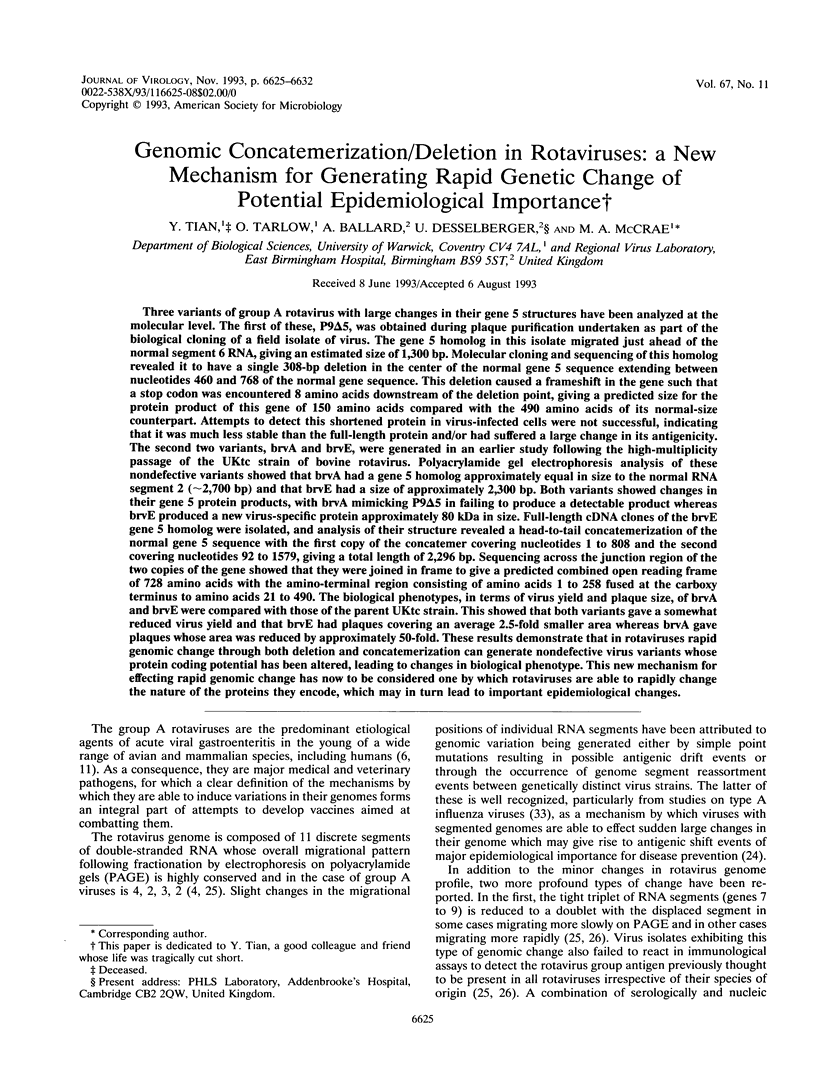
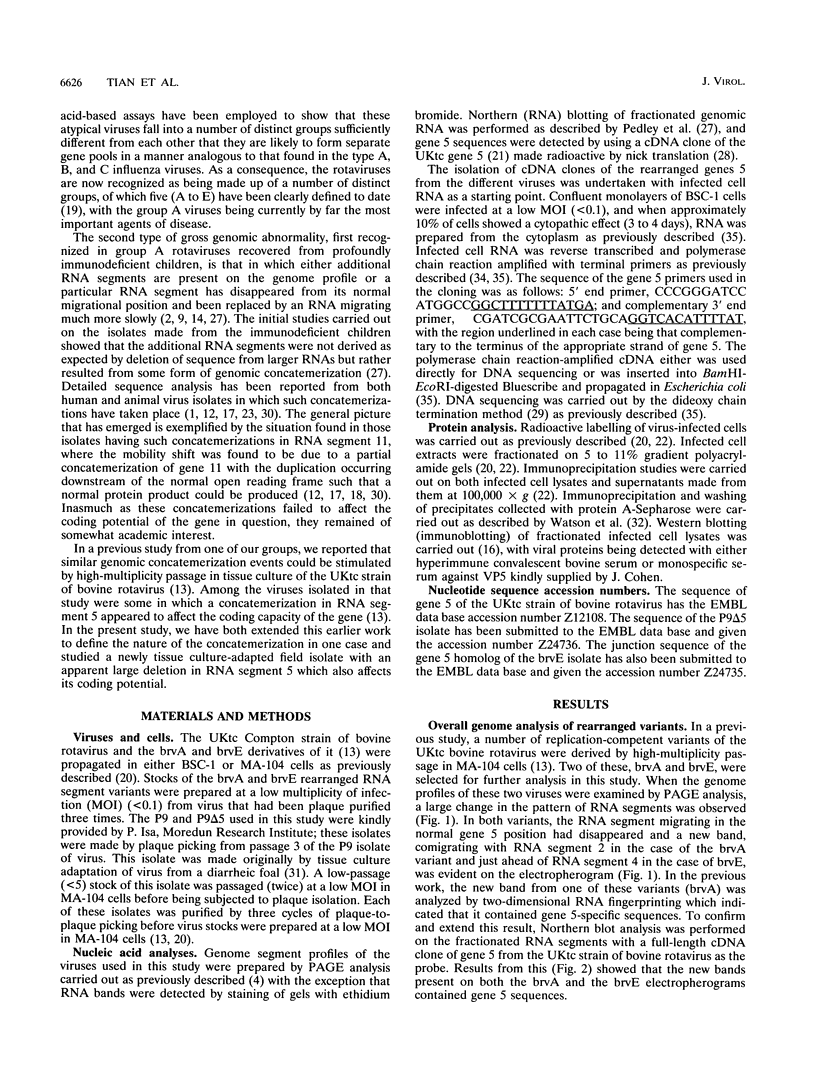
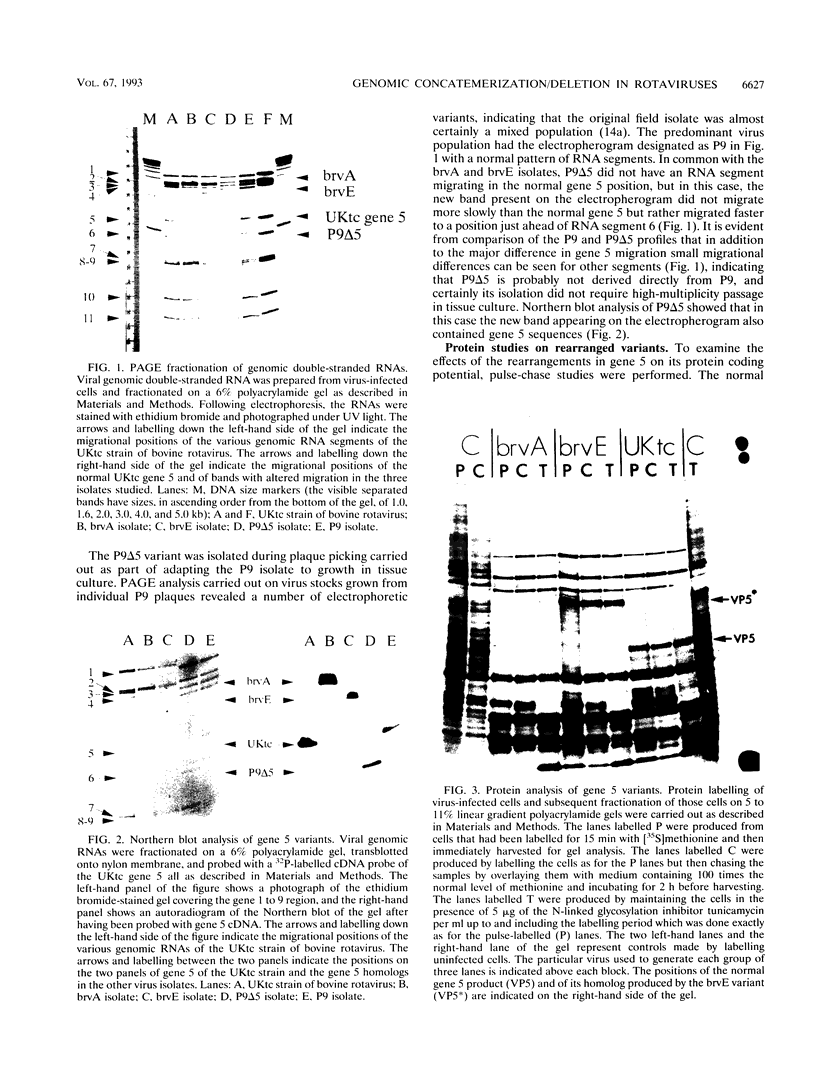
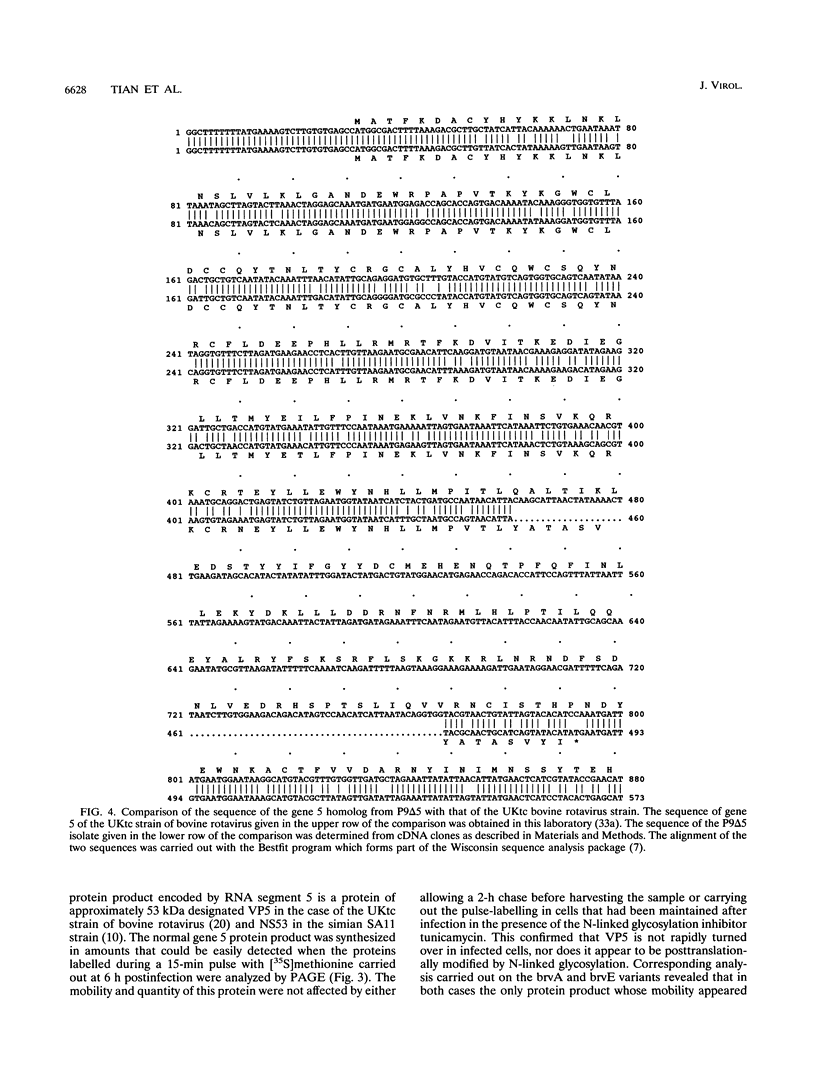
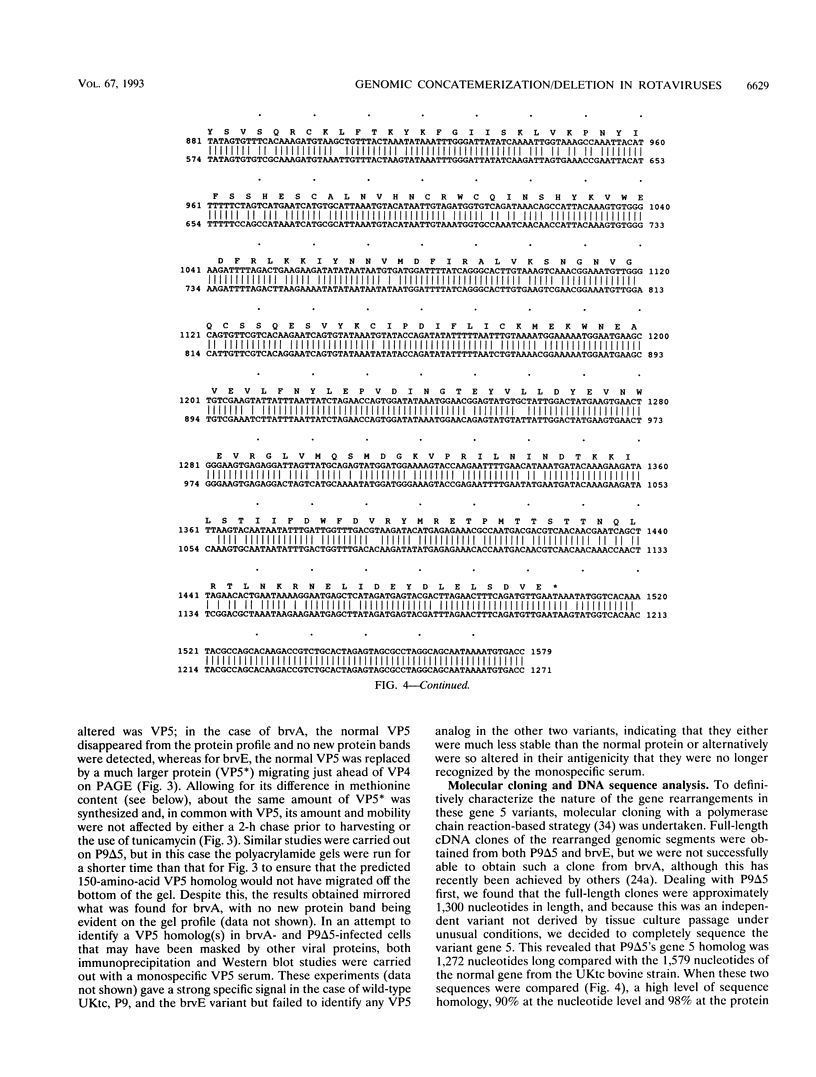

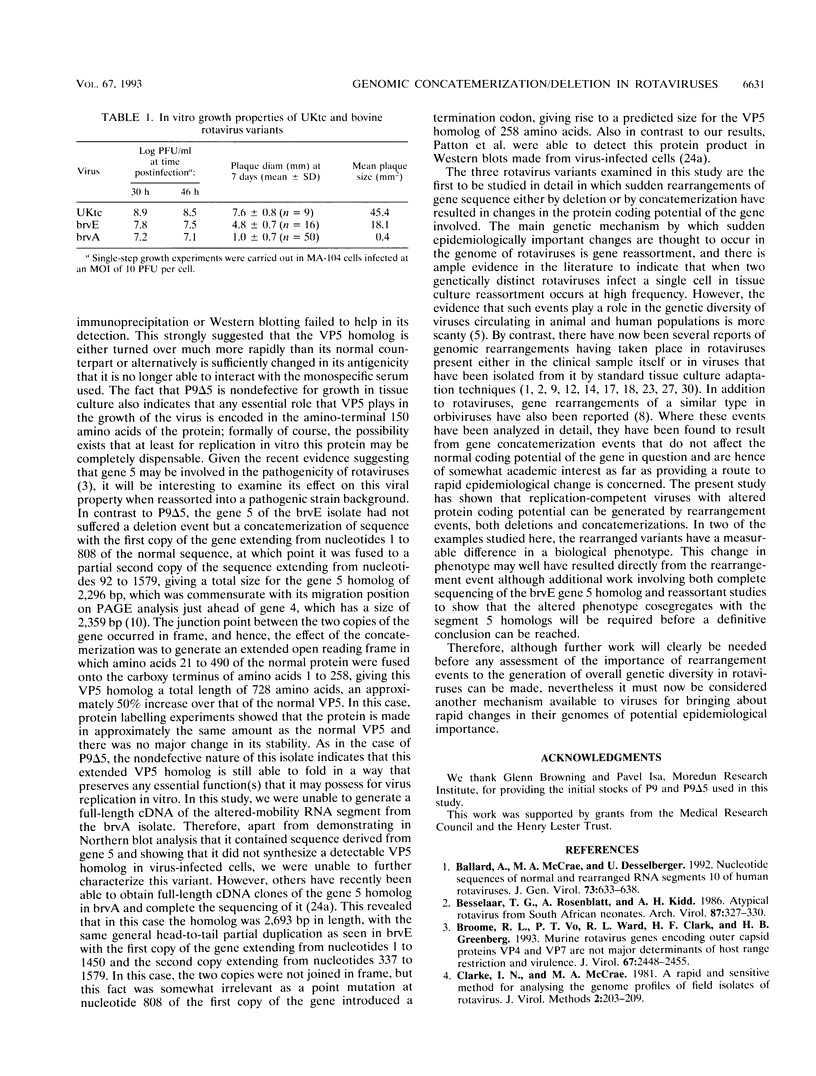
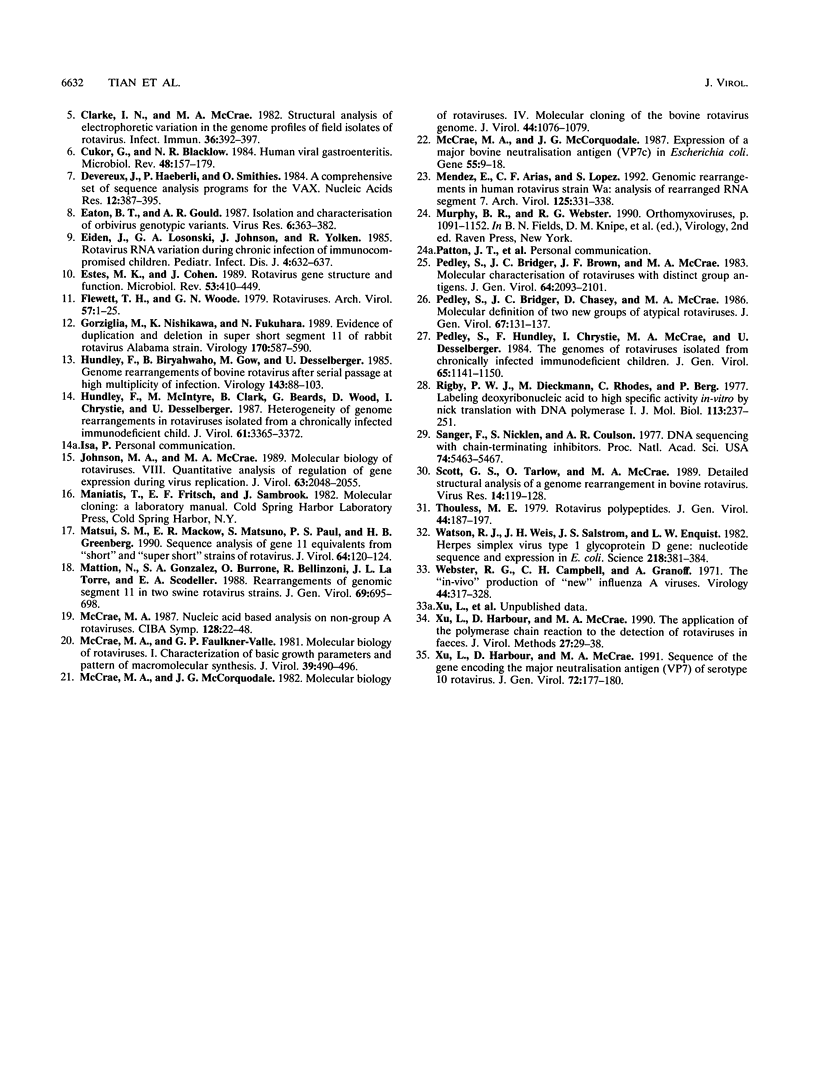
Images in this article
Selected References
These references are in PubMed. This may not be the complete list of references from this article.
- Ballard A., McCrae M. A., Desselberger U. Nucleotide sequences of normal and rearranged RNA segments 10 of human rotaviruses. J Gen Virol. 1992 Mar;73(Pt 3):633–638. doi: 10.1099/0022-1317-73-3-633. [DOI] [PubMed] [Google Scholar]
- Besselaar T. G., Rosenblatt A., Kidd A. H. Atypical rotavirus from South African neonates. Brief report. Arch Virol. 1986;87(3-4):327–330. doi: 10.1007/BF01315311. [DOI] [PubMed] [Google Scholar]
- Broome R. L., Vo P. T., Ward R. L., Clark H. F., Greenberg H. B. Murine rotavirus genes encoding outer capsid proteins VP4 and VP7 are not major determinants of host range restriction and virulence. J Virol. 1993 May;67(5):2448–2455. doi: 10.1128/jvi.67.5.2448-2455.1993. [DOI] [PMC free article] [PubMed] [Google Scholar]
- Clarke I. N., McCrae M. A. A rapid and sensitive method for analysing the genome profiles of field isolates of rotavirus. J Virol Methods. 1981 Mar;2(4):203–209. doi: 10.1016/0166-0934(81)90010-0. [DOI] [PubMed] [Google Scholar]
- Cukor G., Blacklow N. R. Human viral gastroenteritis. Microbiol Rev. 1984 Jun;48(2):157–179. doi: 10.1128/mr.48.2.157-179.1984. [DOI] [PMC free article] [PubMed] [Google Scholar]
- Devereux J., Haeberli P., Smithies O. A comprehensive set of sequence analysis programs for the VAX. Nucleic Acids Res. 1984 Jan 11;12(1 Pt 1):387–395. doi: 10.1093/nar/12.1part1.387. [DOI] [PMC free article] [PubMed] [Google Scholar]
- Eaton B. T., Gould A. R. Isolation and characterization of orbivirus genotypic variants. Virus Res. 1987 Jan;6(4):363–382. doi: 10.1016/0168-1702(87)90067-0. [DOI] [PubMed] [Google Scholar]
- Eiden J., Losonsky G. A., Johnson J., Yolken R. H. Rotavirus RNA variation during chronic infection of immunocompromised children. Pediatr Infect Dis. 1985 Nov-Dec;4(6):632–637. doi: 10.1097/00006454-198511000-00007. [DOI] [PubMed] [Google Scholar]
- Estes M. K., Cohen J. Rotavirus gene structure and function. Microbiol Rev. 1989 Dec;53(4):410–449. doi: 10.1128/mr.53.4.410-449.1989. [DOI] [PMC free article] [PubMed] [Google Scholar]
- Flewett T. H., Woode G. N. The rotaviruses. Arch Virol. 1978;57(1):1–23. doi: 10.1007/BF01315633. [DOI] [PMC free article] [PubMed] [Google Scholar]
- Gorziglia M., Nishikawa K., Fukuhara N. Evidence of duplication and deletion in super short segment 11 of rabbit rotavirus Alabama strain. Virology. 1989 Jun;170(2):587–590. doi: 10.1016/0042-6822(89)90453-4. [DOI] [PubMed] [Google Scholar]
- Hundley F., Biryahwaho B., Gow M., Desselberger U. Genome rearrangements of bovine rotavirus after serial passage at high multiplicity of infection. Virology. 1985 May;143(1):88–103. doi: 10.1016/0042-6822(85)90099-6. [DOI] [PubMed] [Google Scholar]
- Hundley F., McIntyre M., Clark B., Beards G., Wood D., Chrystie I., Desselberger U. Heterogeneity of genome rearrangements in rotaviruses isolated from a chronically infected immunodeficient child. J Virol. 1987 Nov;61(11):3365–3372. doi: 10.1128/jvi.61.11.3365-3372.1987. [DOI] [PMC free article] [PubMed] [Google Scholar]
- Johnson M. A., McCrae M. A. Molecular biology of rotaviruses. VIII. Quantitative analysis of regulation of gene expression during virus replication. J Virol. 1989 May;63(5):2048–2055. doi: 10.1128/jvi.63.5.2048-2055.1989. [DOI] [PMC free article] [PubMed] [Google Scholar]
- Matsui S. M., Mackow E. R., Matsuno S., Paul P. S., Greenberg H. B. Sequence analysis of gene 11 equivalents from "short" and "super short" strains of rotavirus. J Virol. 1990 Jan;64(1):120–124. doi: 10.1128/jvi.64.1.120-124.1990. [DOI] [PMC free article] [PubMed] [Google Scholar]
- Mattion N., González S. A., Burrone O., Bellinzoni R., La Torre J. L., Scodeller E. A. Rearrangement of genomic segment 11 in two swine rotavirus strains. J Gen Virol. 1988 Mar;69(Pt 3):695–698. doi: 10.1099/0022-1317-69-3-695. [DOI] [PubMed] [Google Scholar]
- McCrae M. A., Faulkner-Valle G. P. Molecular biology of rotaviruses. I. Characterization of basic growth parameters and pattern of macromolecular synthesis. J Virol. 1981 Aug;39(2):490–496. doi: 10.1128/jvi.39.2.490-496.1981. [DOI] [PMC free article] [PubMed] [Google Scholar]
- McCrae M. A., McCorquodale J. G. Expression of a major bovine rotavirus neutralisation antigen (VP7c) in Escherichia coli. Gene. 1987;55(1):9–18. doi: 10.1016/0378-1119(87)90243-5. [DOI] [PubMed] [Google Scholar]
- McCrae M. A., McCorquodale J. G. Molecular biology of rotaviruses. IV. Molecular cloning of the bovine rotavirus genome. J Virol. 1982 Dec;44(3):1076–1079. doi: 10.1128/jvi.44.3.1076-1079.1982. [DOI] [PMC free article] [PubMed] [Google Scholar]
- McCrae M. A. Nucleic acid-based analyses of non-group A rotaviruses. Ciba Found Symp. 1987;128:24–48. doi: 10.1002/9780470513460.ch3. [DOI] [PubMed] [Google Scholar]
- Méndez E., Arias C. F., López S. Genomic rearrangements in human rotavirus strain Wa; analysis of rearranged RNA segment 7. Arch Virol. 1992;125(1-4):331–338. doi: 10.1007/BF01309651. [DOI] [PubMed] [Google Scholar]
- Pedley S., Bridger J. C., Brown J. F., McCrae M. A. Molecular characterization of rotaviruses with distinct group antigens. J Gen Virol. 1983 Oct;64(Pt 10):2093–2101. doi: 10.1099/0022-1317-64-10-2093. [DOI] [PubMed] [Google Scholar]
- Pedley S., Bridger J. C., Chasey D., McCrae M. A. Definition of two new groups of atypical rotaviruses. J Gen Virol. 1986 Jan;67(Pt 1):131–137. doi: 10.1099/0022-1317-67-1-131. [DOI] [PubMed] [Google Scholar]
- Pedley S., Hundley F., Chrystie I., McCrae M. A., Desselberger U. The genomes of rotaviruses isolated from chronically infected immunodeficient children. J Gen Virol. 1984 Jul;65(Pt 7):1141–1150. doi: 10.1099/0022-1317-65-7-1141. [DOI] [PubMed] [Google Scholar]
- Rigby P. W., Dieckmann M., Rhodes C., Berg P. Labeling deoxyribonucleic acid to high specific activity in vitro by nick translation with DNA polymerase I. J Mol Biol. 1977 Jun 15;113(1):237–251. doi: 10.1016/0022-2836(77)90052-3. [DOI] [PubMed] [Google Scholar]
- Sanger F., Nicklen S., Coulson A. R. DNA sequencing with chain-terminating inhibitors. Proc Natl Acad Sci U S A. 1977 Dec;74(12):5463–5467. doi: 10.1073/pnas.74.12.5463. [DOI] [PMC free article] [PubMed] [Google Scholar]
- Scott G. E., Tarlow O., McCrae M. A. Detailed structural analysis of a genome rearrangement in bovine rotavirus. Virus Res. 1989 Oct;14(2):119–127. doi: 10.1016/0168-1702(89)90033-6. [DOI] [PMC free article] [PubMed] [Google Scholar]
- Thouless M. E. Rotavirus polypeptides. J Gen Virol. 1979 Jul;44(1):187–197. doi: 10.1099/0022-1317-44-1-187. [DOI] [PubMed] [Google Scholar]
- Watson R. J., Weis J. H., Salstrom J. S., Enquist L. W. Herpes simplex virus type-1 glycoprotein D gene: nucleotide sequence and expression in Escherichia coli. Science. 1982 Oct 22;218(4570):381–384. doi: 10.1126/science.6289440. [DOI] [PubMed] [Google Scholar]
- Webster R. G., Campbell C. H., Granoff A. The "in vivo" production of "new" influenza A viruses. I. Genetic recombination between avian and mammalian influenza viruses. Virology. 1971 May;44(2):317–328. doi: 10.1016/0042-6822(71)90263-7. [DOI] [PubMed] [Google Scholar]
- Xu L., Harbour D., McCrae M. A. Sequence of the gene encoding the major neutralization antigen (VP7) of serotype 10 rotavirus. J Gen Virol. 1991 Jan;72(Pt 1):177–180. doi: 10.1099/0022-1317-72-1-177. [DOI] [PubMed] [Google Scholar]
- Xu L., Harbour D., McCrae M. A. The application of polymerase chain reaction to the detection of rotaviruses in faeces. J Virol Methods. 1990 Jan;27(1):29–37. doi: 10.1016/0166-0934(90)90143-4. [DOI] [PubMed] [Google Scholar]




